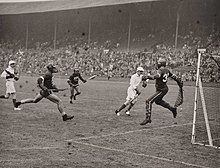Field lacrosse
The sport originated among Native Americans, and the modern rules of field lacrosse were initially codified by Canadian William George Beers in 1867.Defensively the object is to keep the opposing team from scoring and to dispossess them of the ball through the use of stick checking and body contact.[2][3] According to Native American beliefs, playing lacrosse is a spiritual act used for healing and giving thanks to the "Creator".[7][11] In 1867, Montreal Lacrosse Club member William George Beers codified the modern game.A lacrosse ball is made out of solid rubber, measuring 7.75 to 8 inches (19.7–20 cm) in circumference and weighing 5 to 5.25 ounces (140–149 g).Players are required to wear some protective equipment, and must carry a lacrosse stick (or crosse) that meets specifications.[16] If a player enters the "crease" while shooting toward the goal, the referee will call a foul and the ball gets turned over to the other team.The head is roughly triangular in shape and is loosely strung with mesh or leathers and nylon strings to form a "pocket" that allows the ball to be caught, carried, and thrown.The sport's growth has been hindered by the cost of a player's equipment: a uniform, helmet, shoulder pads, hand protection, and lacrosse sticks.[20][21] The introduction of the plastic heads in the 1970s gave players an alternative to the wooden stick,[5] and their mass production has led to greater accessibility and expansion of the sport.[16] A goalkeeper needs to stop shots that are capable of reaching over 100 miles per hour (160 km/h), and is responsible for directing the team's defense.The head of a goalkeeper's crosse may measure up to 15 inches (38 cm) wide, significantly larger than field players'.The method of breaking a tie generally consists of multiple overtime periods of 5 minutes (4 in NCAA play, 10 in [MLL/PLL]) in which whoever scores a goal is awarded a sudden victory.[34][35] International lacrosse plays two straight 5-minute overtime periods, and then applies the sudden victory rule if the score is still tied.Offensive players are responsible for "riding" opponents, in other words attempting to deny the opposition a free "clear" of the ball over the midfield line.Both unsportsmanlike conduct and unnecessary roughness are subject to the officiating crew's discretion, while equipment violations are governed strictly by regulations.Technical fouls include holding, interference, pushing, illegal offensive screening (usually referred to as a "moving pick"), "warding off", stalling, and off-sides.As with a personal foul, until the penalty time expires, no replacement for the player is allowed and the team must play one man short.The player (or a replacement) is allowed to reenter the game once the time in the penalty box is over and the team is thus once again at full strength.College lacrosse, a spring sport in the United States, saw its earliest program established by New York University in 1877.[7][40] The United States Intercollegiate Lacrosse Association (USILA) was created in 1885, and awarded the inaugural Wingate Memorial Trophy to the University of Maryland as national champions in 1936.[44][45][46] Lacrosse was first witnessed in England, Scotland, Ireland and France in 1867 when a team of Native Americans and Canadians traveled to Europe to showcase the sport.[49] The country sponsors various competitions among its states and territories that culminate in the annual Senior Lacrosse Championship tournament.In order to qualify, the Blue Jays won tournaments in the Olympic years to represent the United States.In the past, in order to be considered as an Olympic sport the game had to be played on four continents, and with at least a total of 75 countries participating.[74][75] In October 2023, the LA28 Organizing Committee announced that it had recommended lacrosse as one of five sports that may be added to the program for the 2028 Summer Olympics.The 2008 Under-19 World Lacrosse Championships included twelve countries, with three first-time participants: Bermuda, Finland, and Scotland.[85] The 2007 NCAA Division I Men's Lacrosse Championship weekend held at M&T Bank Stadium in Baltimore, Maryland, was played in front of a total crowd of 123,225 fans for the three-day event.[86] The current attendance record for a regular season lacrosse-only event was set by the 2009 Big City Classic, a triple-header at Giants Stadium which drew 22,308 spectators.[87] The Denver Outlaws hold the professional field lacrosse single-game attendance record by playing July 4, 2015 in front of 31,644 fans.










women's lacrosseKyle Harrisongoverning bodyWorld LacrosseNorth AmericahelmetglovesOlympicSummer Olympics2028 Summer Olympicssixes formatfull contactNative AmericansWilliam George Beerslacrossewomen's field lacrosselacrosse sixesbox lacrosselacrosse sticklacrosse ballWorld Lacrosse ChampionshipsPremier Lacrosse LeagueNational Collegiate Athletic AssociationCanadian University Field Lacrosse AssociationMaritime University Field Lacrosse LeagueAustralian Senior Lacrosse ChampionshipHistory of lacrosselithographGeorge CatlinNative AmericanFrenchJesuitmissionariesSt. Lawrence ValleycrosierOnondaga languageEastern CherokeeMohawkOjibweSoutheastern tribesMontreal Lacrosse ClubCanadian Lacrosse Associationrubbercircumferencemidfieldersdiameterright anglelacrosse helmetlacrosse glovesmouthguardsathletic supporterGoaltender (field lacrosse)radiusbilliardsMidfielder (field lacrosse)college lacrosseMajor League Lacrosseovertimesudden victorypenalty boxman down defenseman upscreeningbasketballNew York UniversityPrinceton UniversityColumbia UniversityHarvard UniversityUnited States Intercollegiate Lacrosse AssociationWingate Memorial TrophyUniversity of MarylandMen's Lacrosse Championship1971 tournamentCornell UniversityvarsityMen's Collegiate Lacrosse AssociationEnglish Lacrosse AssociationQueen VictoriaEuropean Lacrosse Federationbrought to Australiastates and territoriesSenior Lacrosse ChampionshipOntarioQuebecNational Lacrosse LeagueNew BrunswickNova ScotiaAmerican Lacrosse Leagueshot clock2009 MLL seasonwomen'sWorld Lacrosse ChampionshipUnder-19 World Lacrosse ChampionshipsWorld Indoor Lacrosse ChampionshipWomen's Lacrosse World CupLacrosse at the Olympics1904 Summer Olympics1908 Summer OlympicsSaint Louis, MissouriMohawk peopleIroquois ConfederacyLondon, England1928 Summer Olympics1932 Summer Olympics1948 Summer Olympicsdemonstration sportJohns Hopkins Blue Jays lacrosseEnglish Lacrosse UnionRensselaer Polytechnic InstituteOlympic sportUS Lacrosse1996 Summer OlympicsAtlanta, Georgia2000 Summer OlympicsSydney, AustraliaInternational Olympic Committee2008 Men's U-19 World Lacrosse ChampionshipInternational Lacrosse Federation2006 World Lacrosse Championship2010 World Lacrosse ChampionshipManchester, EnglandIroquois Nationals2008 Under-19 World Lacrosse ChampionshipsEuropean Lacrosse Championships2022 World Games2018 World Lacrosse Championship